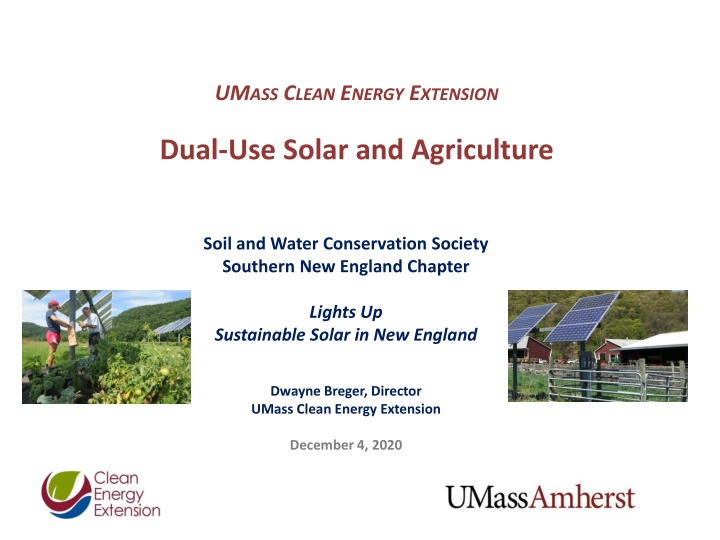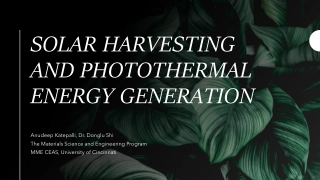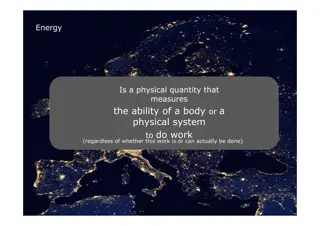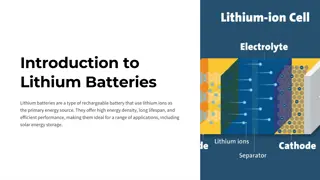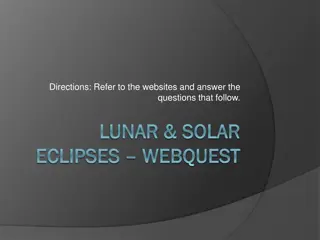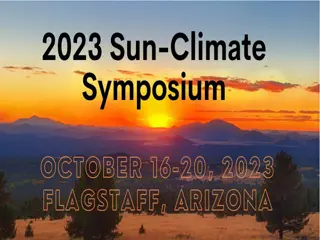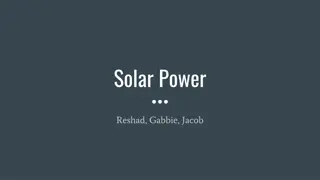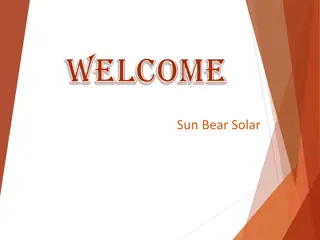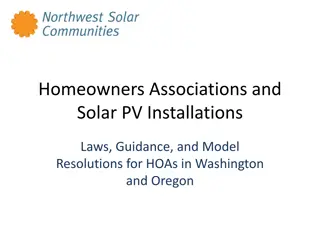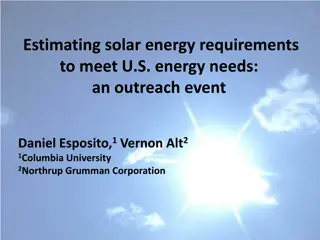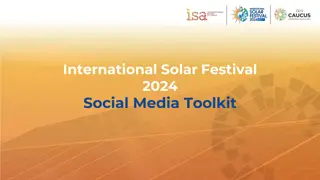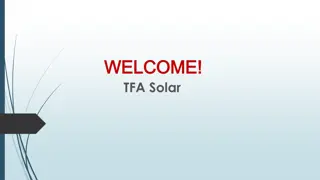Dual-Use Solar and Agriculture
UMass Clean Energy Extension plays a pivotal role in supporting renewable energy, dual-use solar applications, and agricultural practices in New England. They offer outreach, education, and applied research to bolster energy efficiency programs and markets, with a focus on creating a sustainable future. Through collaborations and initiatives, UMass Clean Energy Extension is driving innovation and promoting environmental stewardship in the region.
Download Presentation

Please find below an Image/Link to download the presentation.
The content on the website is provided AS IS for your information and personal use only. It may not be sold, licensed, or shared on other websites without obtaining consent from the author.If you encounter any issues during the download, it is possible that the publisher has removed the file from their server.
You are allowed to download the files provided on this website for personal or commercial use, subject to the condition that they are used lawfully. All files are the property of their respective owners.
The content on the website is provided AS IS for your information and personal use only. It may not be sold, licensed, or shared on other websites without obtaining consent from the author.
E N D
Presentation Transcript
UMASS CLEAN ENERGY EXTENSION Dual-Use Solar and Agriculture Soil and Water Conservation Society Southern New England Chapter Lights Up Sustainable Solar in New England Dwayne Breger, Director UMass Clean Energy Extension December 4, 2020
Outline UMass Clean Energy Extension UMass Extension Role in SMART Dual- Use Program What is Dual-Use and What are We Seeing Research Efforts (U.S. DOE and NREL grants) Questions & Discussion Slide 2
UMass Clean Energy Extension Established in 2015, with support from MA Department of Energy Resources, to help meet the state s energy and climate goals. Expanded UMass extension services under the Center for Agriculture, Food and the Environment (CAFE). Human Resources Small staff of technical professionals, post-doc, graduate research assistants, and contractors Collaborate with faculty/staff across campus disciplines Graduate and undergraduate interns providing workforce training and professional development Slide 3
UMass Clean Energy Extension Support renewable energy and energy efficiency programs and markets for the Commonwealth Provide outreach, education, and applied research On-going technical assistance services Student mentoring, internships, and workforce development Current initiatives o Support for Municipalities and Green Communities MEI Platform o Offshore wind workforce training o Cumulative impacts on wildlife of wind development (with AWWI) o Energy storage o Reducing fuel use by municipal fleets o Community-driven solar siting and financing o Pollinator-friendly solar PV certification o Dual-Use solar PV and agriculture Slide 4
CEE: Supporting DOER SMART Program Facilitating Farm/Solar Land-Use Education, Research, Outreach and Developed Pollinator-Friendly Solar Certification Program Pollinator-Friendly Solar PV Certification Fact Sheets and Outreach In consultation with a range of experts and stakeholders, developed statewide voluntary Pollinator- Friendly Solar PV Certification Program to help solar developers implement, maintain, and promote native meadow habitats under and around solar panels. SMART Program Dual-Use Application Tools and Reporting Working with UMass Extension colleagues and MDAR to provide program support to farm sector on solar adoption generally, and for dual-use solar arrays specifically per state regulations. Slide 5
Massachusetts Land Use and Solar 3rd most densely populated state 62% forest cover ~8.5% agricultural land Top 10 for solar capacity and solar capacity per capita Slide 6
Concept of Dual-Use Does it Make Sense to Combine Ag and Solar? Conventional Land Use 100% Ag Production 100% Solar Production Dual-Use Land Use X% Ag Production X% Ag Production Y% Solar Production Y% Solar Production Schematic Adapted from Fraunhofer ISE Question: Does total production of dual-use land use outweigh conventional land use for solar and agriculture? That is, is 2X% Ag + 2Y% Solar > 100%Ag + 100% Solar? Slide 7
UMASS EXTENSION INVOLVEMENTIN DUAL-USE REGULATIONAND RESEARCH SMART Program: Review draft Pre-Determination applications for dual-use projects, and provide feedback to farmers and solar developers Review regulations and scientific literature, provide information regarding dual-use to farmers and developers Conduct research on small-scale array at UMass Research Farm Conduct research on dual-use cranberry projects at Cranberry Experimental Station Participate in national dual-use development and seek additional research opportunities 8
SMART DUAL-USE APPLICATION PROCESS Standard application through SMART for solar component of project Pre-Determination Form submitted to Clean Energy Extension for comment. Review by Clean Energy Extension and relevant Agricultural Extension staff/faculty Extension comments provided to applicant, shared with MDAR, DOER Site visit, typically with farmer, solar developer, MDAR, Clean Energy Extension, and Agricultural Extension staff Application revisions and submission to MDAR, DOER Annual Reports filed to MDAR, DOER throughout eligibility 9
PRE-DETERMINATION FORM COMPONENTS Applicant Information Contact information for applicant, farmer, developer, land-owner Basic Farm Information Type of production, total acreage, annual sales, anticipated changes to farm business Site Information Location, land status, soils, property map Solar Array Design Capacity, type of system, design, ground penetration, site plan Shading Analysis Using SMART shading tool Agricultural Plan Crop or grazing narrative, farm equipment table, anticipated yield, crop rotation (if applicable) 10
SMART REVIEWS WHAT WERE SEEING Total Projects: 26 applications received, about 2/3rds expected to complete pre-determination process 10 for active cranberry bogs 7 were primarily for livestock grazing (principally beef cattle, heifers, and cow-calf pairs, chickens, turkeys, sheep) 5 application was for mixed hay and grazing 4 applications were for squash/pumpkins or mixed vegetables Farm Ownership: Approx. 18 applications with farmer as current landowner, but of these, half are planning to retire or sell within 5 years Many proposals for marginal or currently unused farmland Construction of first systems planned for 2020-2021 (this fall and winter) 11
SMART REVIEWS WHAT WERE SEEING Significant developer concern with 2 MW size limit Many unknowns regarding crop production Limited research on impact of shading on crops Annual reporting process will be informative but anecdotal 12
U.S. DOE RESEARCH GRANT UMass CEE selected for 2020 award from U.S. DOE Solar Energy Technology Office Impacts of Dual-Use Solar on Crop Productivity and the Agricultural Economy in Massachusetts and Beyond Academic, Public, Private Collaboration UMass Center for Food, Agriculture and the Environment (CAFE) UMass Extension Cranberry Station Dept. of Resource Economics American Farmland Trust (AFT) Solar Developers & Farm Manager BlueWave Solar Pine Gate Renewables Hyperion Systems LLC Iain Ward (Farm Manager) State Agencies MA Department of Agricultural Resources (MDAR) MA Department of Energy Resources (DOER) 3-Year Program; $1.8M federal award; est. start March 2021 Establish and monitor up to 8 MA dual-use research site trails Perform and resource economic analysis of farm viability, agricultural economy, and community acceptability 13
U.S. DOE RESEARCH GRANT Integrated with commercial Dual-Use projects with 3 solar developers and 8 farms Crops: Cranberry, vegetables, squash, hay, grazing First site trials expected next growing season 14
Dual-Use Selected Resources CEE s dual-use resource page: https://tinyurl.com/y5gc4gjx NREL s InSPIRE Program: https://tinyurl.com/y3mkd5re Slide 15
SOLARIN RURAL COMMUNITIES NREL SOLAR ENERGY INNOVATION NETWORK UMass CEE working with 3 pilot western MA towns to prepare towns for solar development Community-Informed Proactive Solar Siting and Financing Partners Solar Siting Assessment and Development Scenarios Blanford, Wendall, Westhampton PVPC, FRCOG MDAR, DOER, MassCEC PV Squared Northeast Solar Co-op Power UMassFive College Credit Union Western Massachusetts Community Choice Energy Task Force Cash Flow, Financing, and Ownership Strategies Stakeholder/Community Preferences Survey and Engagement Tool Kit for replicable town actions 16
Thank You. Questions? Dwayne Breger dbreger@umass.edu UMass Clean Energy Extension Email energyextension@umass.edu website www.ag.umass.edu/clean-energy facebook www.facebook.com/umasscleanenergyextension twitter @UMassEnergyExt
